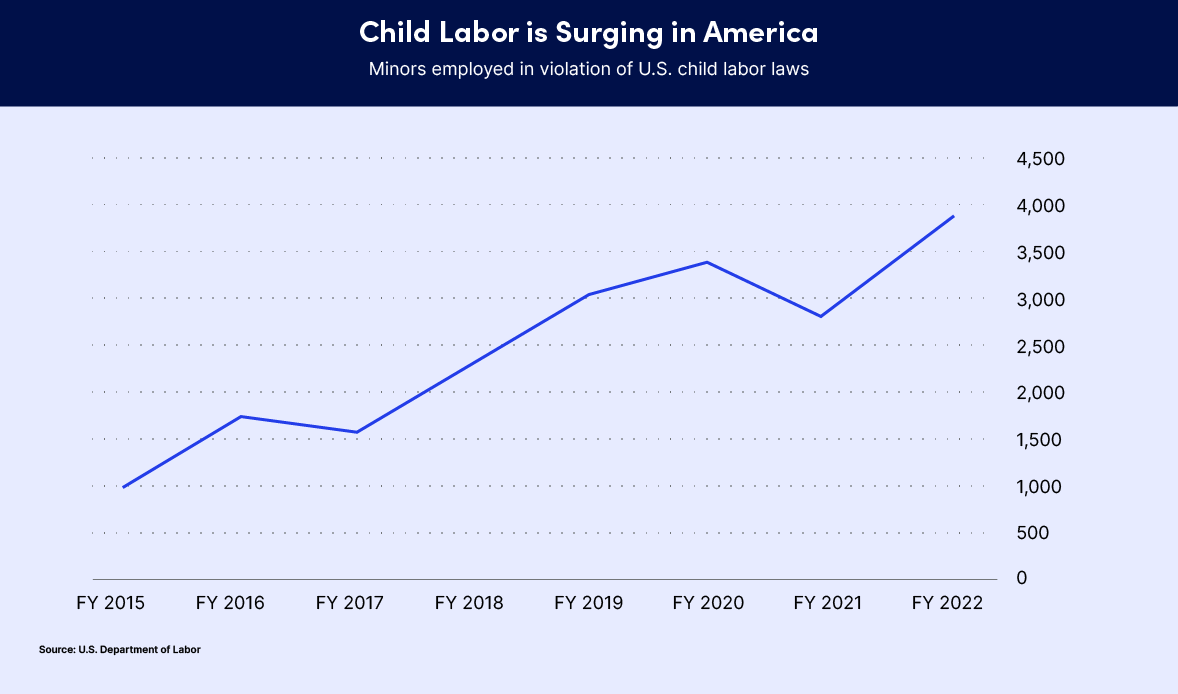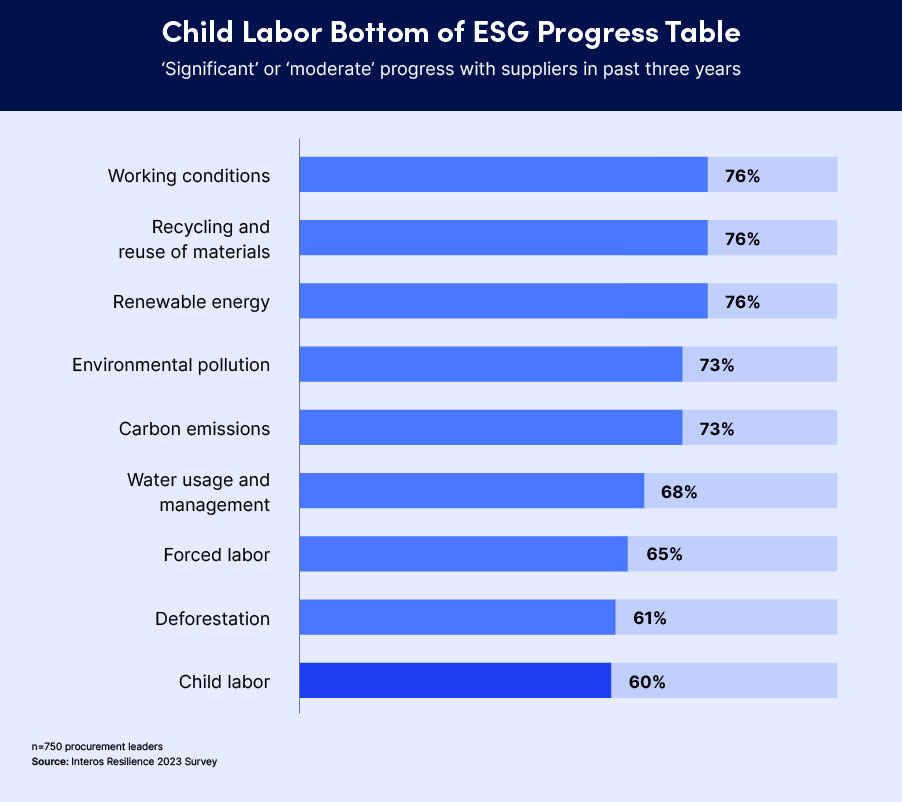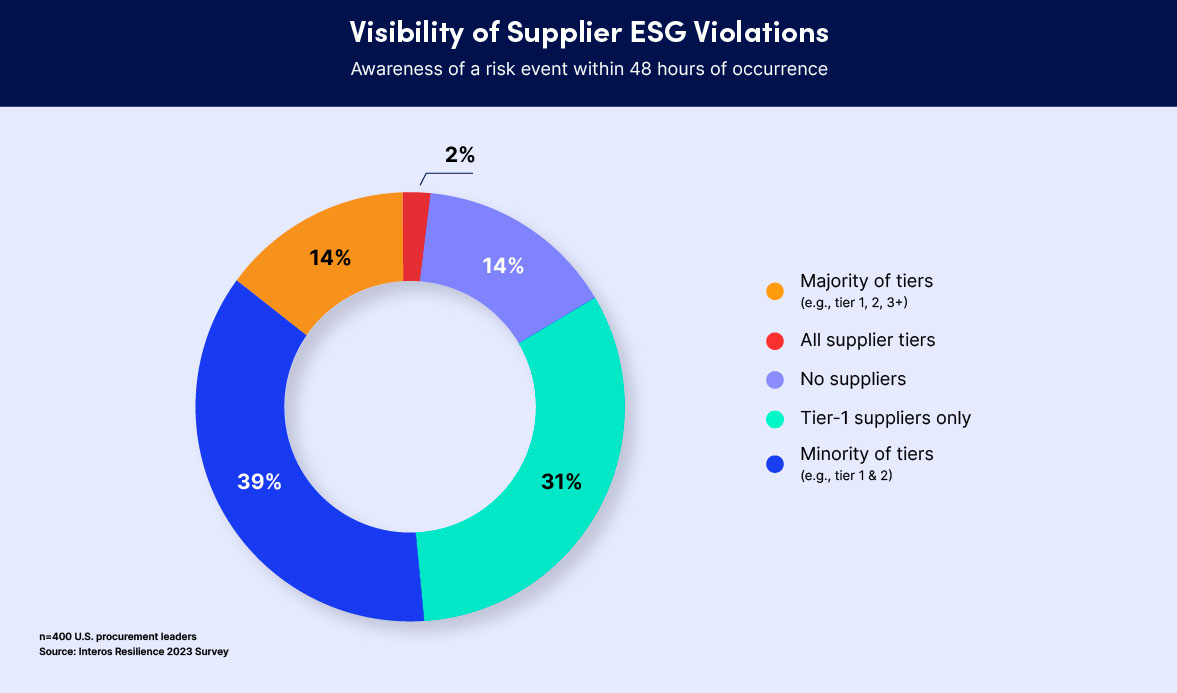By Geraint John and Taiwo Ogunbayo
Child labor is an issue most often associated with countries in the developing world – but it’s also a growing risk for companies with supply chains in the United States.
Investigations by U.S. government agencies, research firms, non-governmental organizations and media outlets reveal a spike in the number of children working illegally for U.S.-based suppliers, some of them used by major American companies. Since the beginning of 2022, Interos has identified 139 companies implicated in breaches of child labor regulations in the U.S. alone.
In June, an ESG advisory firm owned by Goldman Sachs downgraded U.S. supply chains from “medium” risk to “high” risk, in part because of the treatment of migrant and other children.
Aside from financial penalties for non-compliance with child labor laws, U.S. firms run the risk of damaging their brand reputations by being associated with illegal practices taking place within their domestic supply chains.
A Global Problem Mirrored in the U.S.
Child labor is a growing problem globally. Around 160 million children aged 17 or under – almost 1 in 10 of the world’s population – were working in factories, on the land or in other jobs in 2020, according to Unicef.
This figure was up by over 8 million on 2016 estimates, with agriculture accounting for more than 70% of children in work.
However, this growth is not limited to traditional hotspots in Sub-Saharan Africa, Pakistan, India and other developing countries. In February, the U.S. Department of Labor announced a crackdown after the number of child labor law violations jumped by 69% since 2018 and 283% since 2015 (see chart).
The U.S. Fair Labor Standards Act (FLSA) of 1938 sets a minimum working age of 14 and limits the number of hours that can be worked by minors under 16. The act also bars those under 18 from working in hazardous occupations.
The labor department’s most recent data shows that:
- The U.S. government has successfully prosecuted 835 cases involving the illegal employment of more than 3,800 children in U.S. fiscal year 2022.
- The annual number of cases involving children working in hazardous jobs almost doubled, to 688, between 2015 and 2022.
- Fines for child labor law violations totaled almost $4.4 million in FY 2022 – up 315% on 2015.

Cases Reflect Migration and Labor Market Conditions
Since 2022, Interos has documented 139 companies implicated in breaches of child labor regulations in the U.S. Our analysis found that:
- These entities are connected to more than 600 U.S.-based customers, heightening the risk of child labor violations for those companies.
- The sectors with the highest incidence of violations include food services and restaurants, transportation equipment manufacturing, and administrative support services.
Media reports over the past year have highlighted a number of cases in these and other industry supply chains of major U.S. and foreign companies. For example:
- An investigation by Reuters last year discovered underage children being used in auto parts factories supplying South Korean car makers Hyundai and Kia in Alabama.
- Earlier this year, a Wisconsin-based cleaning supplier used by JBS Foods, Cargill, Tyson Foods and other meat processing firms was fined $1.5 million for illegally employing more than 100 minors at sites across eight U.S. states in the south and Midwest.
- The Department of Labor investigated a Michigan-based snack-food and cereal manufacturer supplying household-name brands after being called out in a New York Times article.
Migrant children are particularly at risk. There has been a big rise in the number of Central American children sent unaccompanied by their parents to work in the U.S. More than 250,000 are reported to have entered the country in the past two years alone.
Another contributing factor is the state of the U.S. labor market. With firms in many industries hit by rising wage costs and a shortage of workers, pressure on state legislators to relax some FLSA regulations has intensified.
To date, 14 states – including Arkansas and Iowa – have proposed or enacted laws that weaken federal restrictions on child labor, according to the Economic Policy Institute.
With an increasing number of states relaxing their child labor regulations, the U.S. is likely to see a continued rise in the number of reported and investigated cases over the next few years.
Child Labor Requires Focus and Visibility
Perhaps because it is regarded as a “developing world problem”, child labor has not been as high on the ESG agenda for many Western firms as either environmental issues or other working conditions such as forced labor.
A recent Interos survey of 750 procurement leaders in the U.S., Canada, the U.K. and Ireland found that child labor ranked the lowest of nine ESG activities, in terms of the progress made with suppliers to tackle it during the past three years (see chart).
Almost one-quarter of the 400 U.S. respondents in aerospace & defense, financial services, energy, healthcare and federal government reported either no progress or regression on child labor. Only 10% believed this type of supply chain risk was “not applicable” to their organizations.

One of the main barriers to making progress with suppliers on child labor, as on other ESG issues, according to our survey findings, is a lack of sub-tier visibility.
A common source of supplier risk in several recent U.S. cases is recruitment agencies, which are often present two or three tiers deep in the supply chain. Several have been blamed for supplying children to customer workplaces without properly verifying their ages or legal status.
Not knowing who your tier-1 or tier-2 suppliers use for staffing, other services such as cleaning and catering, as well as product manufacturing, in turn results in a lack of awareness about both child labor risks and specific instances of illegal activity.
Just 16% of U.S. procurement leaders were confident they would be aware of a supplier ESG violation in most or all of their supply chain tiers within 48 hours (see chart).

What American Leaders Need to Do
To manage domestic regulatory and reputational risk around child labor effectively, U.S. procurement and supply chain leaders need to:
- Strengthen sourcing policies and supplier codes of conduct to make it clear that the illegal use of child labor in U.S. operations is unacceptable.
- Ensure that contractual terms specify the right to on-site audits of direct and, in certain circumstances, indirect suppliers to check they abide by federal and state child labor laws.
- Invest in software tools to map multi-tier supplier relationships, model supplier ESG risks, and continuously monitor events involving the potential use of child labor.
- Keep a close watch on suppliers in sectors implicated in employing illegal child labor, such as cleaning services, contingent staffing, and low-valued-added product manufacturing.
- Assess child labor risks and mitigation plans in regular review meetings with key suppliers.
The growing catalog of evidence and convictions demonstrates that child labor is not an issue that U.S. companies should be concerned about only in their foreign supply chains; it is one that also requires action in multiple industry sectors within America itself.
As with other forms of ESG risk, complacency is not a safe route to compliance.





